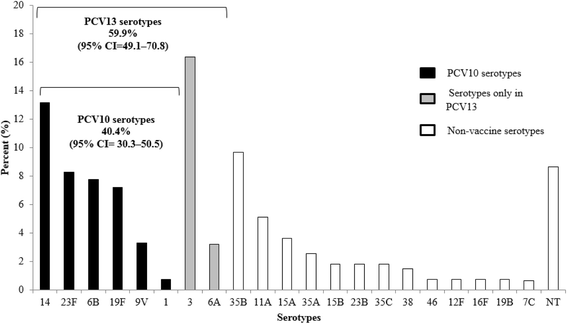Pneumococcal carriage and antibiotic susceptibility patterns from two cross-sectional colonization surveys among children aged <5 years prior to the introduction of 10-valent pneumococcal conjugate vaccine - Kenya, 2009-2010
- PMID: 28056828
- PMCID: PMC5217209
- DOI: 10.1186/s12879-016-2103-0
Pneumococcal carriage and antibiotic susceptibility patterns from two cross-sectional colonization surveys among children aged <5 years prior to the introduction of 10-valent pneumococcal conjugate vaccine - Kenya, 2009-2010
Abstract
Background: Pneumococci are spread by persons with nasopharyngeal colonization, a necessary precursor to invasive disease. Pneumococcal conjugate vaccines can prevent colonization with vaccine serotype strains. In 2011, Kenya became one of the first African countries to introduce the 10-valent pneumococcal conjugate vaccine (PCV10) into its national immunization program. Serial cross-sectional colonization surveys were conducted to assess baseline pneumococcal colonization, antibiotic resistance patterns, and factors associated with resistance.
Methods: Annual surveys were conducted in one urban and one rural site during 2009 and 2010 among children aged <5 years. To reflect differences in vaccine target population, recruitment was age-stratified in Kibera, whereas a simple random sample of children was drawn in Lwak. Nasopharyngeal swabs were collected from eligible children. Pneumococci were isolated and serotyped. Antibiotic susceptibility testing was performed using the 2009 isolates. Antibiotic nonsusceptibility was defined as intermediate susceptibility or resistance to ≥1 antibiotics (i.e., penicillin, chloramphenicol, levofloxacin, erythromycin, tetracycline, cotrimoxazole, and clindamycin); multidrug resistance (MDR) was defined as nonsusceptibility to ≥3 antibiotics. Weighted analysis was conducted when appropriate. Modified Poisson regression was used to calculate factors associated with antibiotic nonsusceptibility.
Results: Of 1,087 enrolled (Kibera: 740, Lwak: 347), 90.0% of these were colonized with pneumococci, and 37.3% were colonized with PCV10 serotypes. There were no differences by survey site or year. Of 657 (of 730; 90%) isolates tested for antibiotic susceptibility, nonsusceptibility to cotrimoxazole and penicillin was found in 98.6 and 81.9% of isolates, respectively. MDR was found in 15.9% of isolates and most often involved nonsusceptibility to cotrimoxazole and penicillin; 40.4% of MDR isolates were PCV10 serotypes. In the multivariable model, PCV10 serotypes were independently associated with penicillin nonsusceptibility (Prevalence Ratio: 1.2, 95% CI 1.1-1.3), but not with MDR.
Conclusions: Before PCV10 introduction, nearly all Kenyan children aged <5 years were colonized with pneumococci, and PCV10 serotype colonization was common. PCV10 serotypes were associated with penicillin nonsusceptibility. Given that colonization with PCV10 serotypes is associated with greater risk for invasive disease than colonization with other serotypes, successful PCV10 introduction in Kenya is likely to have a substantial impact in reducing vaccine-type pneumococcal disease and drug-resistant pneumococcal infection.
Keywords: 10-valent pneumococcal conjugate vaccine; Antibiotic nonsusceptibility; Colonization; Kenya; Streptococcus pneumoniae.
Figures


References
-
- Scott JA. The preventable burden of pneumococcal disease in the developing world. Vaccine. 2007;25(13):2398-405. - PubMed
-
- Pneumococcal disease [http://www.who.int/ith/diseases/pneumococcal/en/]. Accessed 14 Sept 2015.
-
- Estimated Hib and pneumococcal deaths for children under 5 years of age, 2008 [http://www.who.int/immunization/monitoring_surveillance/burden/estimates...]. Accessed 10 Dec 2015.
-
- O’Brien KL, Wolfson LJ, Watt JP, Henkle E, Deloria-Knoll M, McCall N, Lee E, Mulholland K, Levine OS, Cherian T, et al. Burden of disease caused by streptococcus pneumoniae in children younger than 5 years: global estimates. Lancet. 2009;374(9693):893–902. doi: 10.1016/S0140-6736(09)61204-6. - DOI - PubMed
MeSH terms
Substances
LinkOut - more resources
Full Text Sources
Other Literature Sources
Medical

